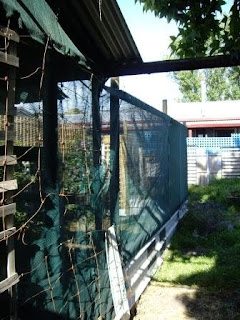
I have had some time off studying and less work with the holidays and decided to renovate the chicken house.
The old one was too shady in the winter and didn’t provide enough cover when it rained it was basically an old shade house, and it meant the chickens had to be allowed to wander the garden for a few hours a day. This means they ‘poop’ by the back door, eat all the strawberries and destroy the garden. However they do eat all the slugs and snails.

After much thought, I decided to leave the frame of the old shade house, it is solid steel and all welded together, and its in a good location near the London Plane which provides shade and cooling in the summer, but being deciduous lets more sun in the winter.
 |
| Nesting box |

The roof is built out of corrugated iron that was left over from the last garden, all fixed using screws, then it can be used again, I found a large piece at the tip shop, and only had to buy one piece new. I canabalised the shade house for their ‘run’ and plan to plant two fruit trees in there. The girls like to hide under shrubs and eat the leaves and generally play underneath trees. Also they will eat the dropped fruit and prevent pests and diseases.
A friend gave me some old fencing wire which I plan to grow Chinese jasmine up, beautiful scent and will cope with the shade. There will be a garden bed around the house, and the water from the bathroom, will run into an agi pipe under the bed. I found an enormous roll at the tip shop.
 |
| Brown leghorns and Old english game birds, getting into the camera |
The chickens like a bit of privacy and it is easy to access the eggs from outside the coop, this old cupboard is perfect. The boxes are lined with newspaper easier for cleaning and bedding is sugar cane mulch , holes are drilled in the bottom for ventilation.
The chickens are three different breeds, old english game birds, very feisty they were bred as fighting birds and can be quite noisy, they ahve survived two dog attacks though. A good old isa brown, she is getting on a bit, but is wise old thing. Three brown leghorns, these are great one is a survivor of the dog attack and the other two were recompense from the dog owner. Why cant people control their dogs, ugh, they bark all night and then attack my animals. They now have new security.

A friend of mine wanted to keep bees but had nowhere to keep them as his wife objected to Bees. I was more than happy. Apparently they produce up to 90kgs a new. I think the end of sugar in my house
